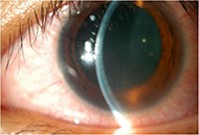Anterior uveitis: is this the cause of a red eye?
Uveitis is defined as inflammation of the uveal tract. The uvea is the tissue and structures of the eye between the tough outer scleral layer and the innermost retina and is anatomically divided into the iris, ciliary body and choroid. Uveitis may be classified according to its aetiology or clinical features; however, it is conveniently described in terms of the affected structures. Anterior uveitis is inflammation affecting the iris (iritis) or anterior ciliary body (iridocyclitis). Intermediate uveitis affects the posterior ciliary body (pars planitis) and peripheral retina, often manifesting with inflammatory cells in the vitreous. Posterior uveitis involves the choroid and posterior retina, whereas panuveitis involves the entire uveal tract.
Inflammation in each part of the uvea manifests in different ways according to the structures affected, their sensitivity to pain and their propensity to affect vision. Anterior uveitis tends to cause pain and photophobia in addition to redness of the eye. Intermediate uveitis may simply present with mild visual loss or floaters due to inflammatory cells or debris in the vitreous, whereas posterior uveitis may cause mild to profound visual loss, floaters and occasionally other symptoms, such as visual field loss and photopsias, depending on which areas of the retina are involved.

